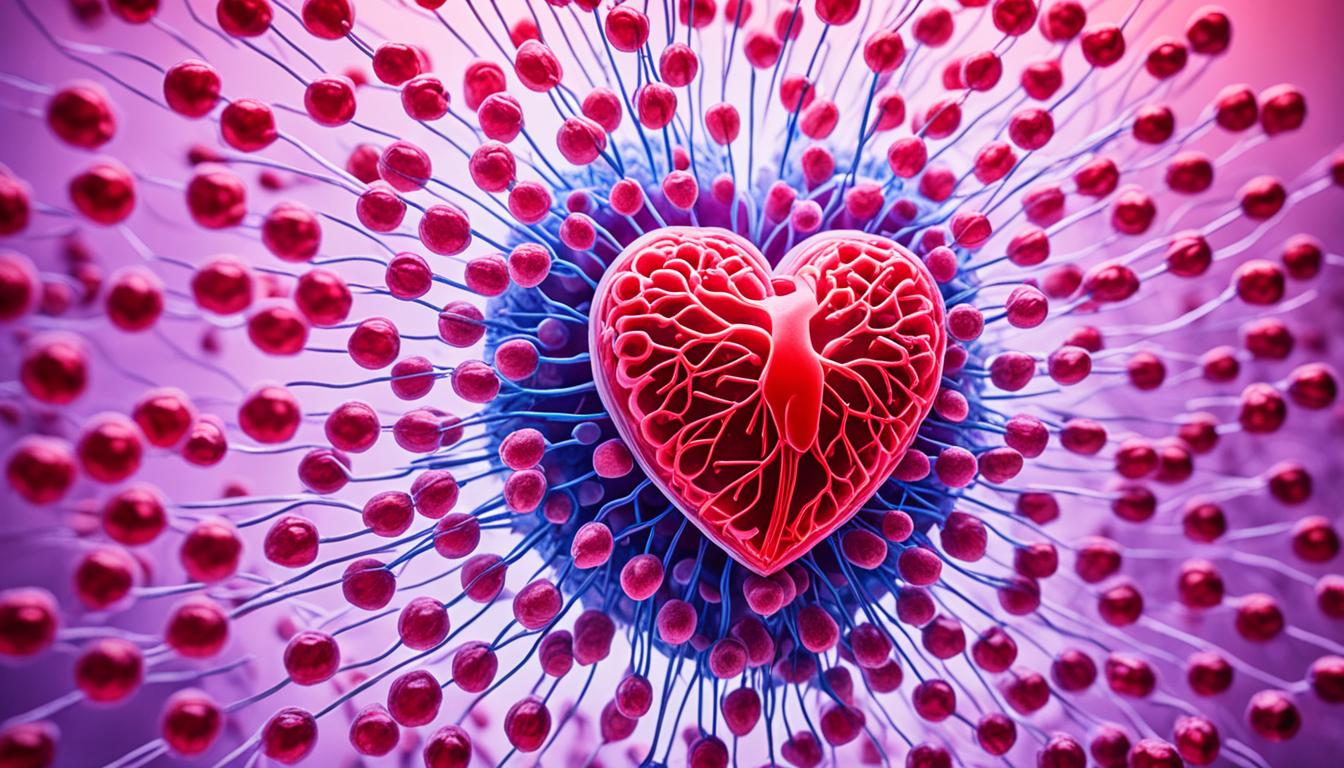Ventricular tachycardia is a serious heart condition with a fast heart rate. It comes from the heart’s lower chambers. This problem can be very dangerous and needs quick medical help. People with this condition may feel their heart racing, dizzy, have chest pain, or even pass out.
Several things can lead to ventricular tachycardia. This includes heart disease, a past heart attack, and some drugs. It’s important to find the exact cause through proper diagnosis. This helps in giving the right treatment.
Getting a diagnosis for ventricular tachycardia often starts with an ECG. It checks the heart’s electrical activity for any problems. Other tests are done to look deeper. They also show how bad or often the fast heartbeats happen. This info helps draft a solid treatment plan.
Stem cell therapy is a new hope for ventricular tachycardia. Doctors are studying how stem cells might help heal the heart. The goal is to fix damaged heart tissue and make the heart work better.
Key Takeaways:
- Ventricular tachycardia is a serious cardiac condition characterized by a rapid heart rate originating in the ventricles.
- Symptoms of ventricular tachycardia include palpitations, dizziness, chest pain, and fainting.
- The condition can be caused by various factors, including heart disease, previous heart attack, and certain medications.
- Diagnosis involves an electrocardiogram (ECG) and other tests to identify the underlying cause.
- Stem cell therapy is being explored as a potential treatment option for ventricular tachycardia, aiming to regenerate damaged heart tissue.
Types and Symptoms of Ventricular Arrhythmias
Ventricular arrhythmias are abnormal heart rhythms that start in the ventricles. They can be very dangerous. These heart problems make your heart beat too quickly. There are different kinds, each with its own signs and symptoms.
Ventricular tachycardia is the usual type. It makes the heart beat fast and steadily from the ventricles. This rapid rhythm can cause palpitations, chest pain, difficulty breathing, and even fainting.
Ventricular fibrillation is another type. In this condition, the heart beats in a wild, irregular way. The heart doesn’t pump blood right, and it needs immediate help.
Premature ventricular contractions (PVCs) are less worrying. They happen when the ventricles contract too soon, making your heart feel like it skips a beat. While often harmless, too many or too troubling PVCs need a doctor’s checkup.
Remember, symptoms of ventricular arrhythmias can differ from person to person. Some might feel nothing, while others suffer a lot. If you think you have a ventricular arrhythmia, don’t wait. See a doctor for a proper check and care.
Diagnosis and Treatment of Ventricular Tachycardia
The process of diagnosing ventricular tachycardia (VT) starts with an electrocardiogram (ECG). This test records the heart’s electrical activity. It helps show if the heart’s rhythm is normal or not. Other tests like echocardiography, stress tests, and cardiac catheterization may also happen. They check the cause of VT and how well the heart works.
After VT is diagnosed, the right treatment is chosen. This depends on how serious the condition is and the patient’s health. Treatments can include antiarrhythmic drugs, catheter ablation, or implantable cardioverter-defibrillators (ICDs).
Antiarrhythmic drugs are usually the first step against VT. These medicines help keep the heart’s rhythm normal and reduce VT episodes. Doctors might use drugs like amiodarone, sotalol, or flecainide. However, the choice of drug is based on the patient’s health and what they can handle.
Catheter ablation is a procedure to fix the heart’s rhythm. It’s done through a small tube in the veins to the heart. Then, a specific energy type is used to change the part of the heart causing the problem. This method helps get rid of or lessen VT episodes, especially when drugs don’t work well.
If VT is very bad or treatments don’t help, an implantable cardioverter-defibrillator (ICD) may be the best choice. An ICD is like a small computer under the skin near the chest. It keeps watch over the heart. If a major VT episode comes, the ICD can give a shock to fix the rhythm. ICDs are really good at stopping sudden heart stops in VT patients.
Each treatment has its good and bad points. Deciding on a treatment is based on looking at the patient’s history, symptoms, and health. It’s important to see a heart specialist to figure out the best way to treat VT.
The Role of Lifestyle Modifications
Lifestyle changes can help with managing ventricular tachycardia. This might include:
- Finding and avoiding what causes VT, like too much coffee, alcohol, or very hard activity.
- Learning how to lower stress, like through meditation, breathing exercises, or hobbies that calm you.
- Eating foods that are good for your heart and avoiding unhealthy fats and salt.
- Exercising the right amount, as advised by a doctor, to keep your heart strong.
- Stopping smoking to lower your chances of heart problems.
These changes are not the only answer for VT, but they can help. Always talk to your doctor before making big changes. They can make sure the changes are right for you.
Stem Cell Therapy for Ventricular Tachycardia
Stem cell therapy is a new way to treat heart problems like ventricular tachycardia. It uses the power of stem cells to fix damaged heart tissue. This can help the heart work better. Scientists are looking at different types of stem cells to see if they can fix the heart.
Studies on stem cell therapy for ventricular tachycardia are giving hope. Patients who have had this treatment saw their heart function get better. They also had fewer heart rhythm problems. But, there’s more to learn about how to use stem cells best and what their long-term effects are.
Regenerative medicine is making big steps in treating ventricular tachycardia. Using stem cells could repair the heart, making it work better. This means patients could have a better life with this condition.

